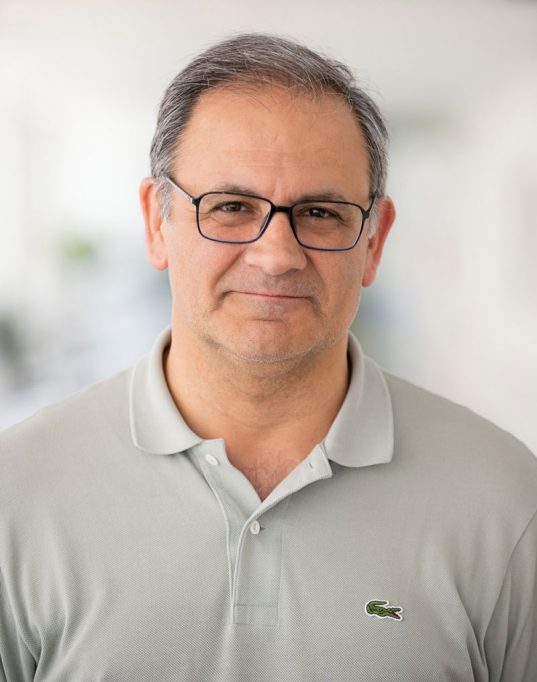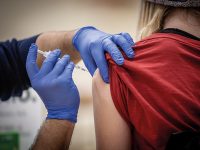Interview with Esteban Martínez
«It will be months before we know the impact of the COVID-19 pandemic on people living with HIV»
Doctor and president of GESIDA
Since the beginning of the year, health news has focused on the COVID-19 crisis. However, the pandemic has confirmed that infectious diseases can only be tackled globally. That is why the World AIDS Day theme chosen by the United Nations for this year is «Global solidarity, shared responsibility». Around 38 million people are living with HIV worldwide and although access to antiretroviral therapy has increased significantly over the past ten years, it still remains uneven in many areas and countries. «In Spain, there are an estimated 150,000 people living with HIV, approximately 20% of whom are unaware of their status», reports Esteban Martinez, President of GESIDA, the AIDS Study Group of the Spanish Society of Infectious Diseases and Clinical Microbiology (SEIMC). He works as a doctor and researcher at the Clinical Hospital of Barcelona and as an associate professor at the University of Barcelona. We talked to him about how this unusual year has affected HIV management.
Has COVID-19 changed our understanding of epidemics?
Yes, it has changed our whole lives and, in the field of epidemics, we have been able to see that there are diseases with factors that favour transmission and, with them, each one of us can be at the same time affected and also contribute to breaking the chain of potential contagion.
Are people with HIV at increased risk of being infected with COVID-19?
We do not have a definitive answer. On the one hand, there is some information that people with HIV – like others with chronic diseases – may be more vulnerable because of their illness and, in this case, because of a compromised immune system. But one could also think that they may be more protected, either by the HIV infection itself or by antiretroviral medication. I think it is important to distinguish between several elements. One is the risk of infection itself. In this area, the initial information we had is that, paradoxically, people with HIV were at lower risk of infection than the general population. But, in a study from our area and in others, we have seen that this lower initial incidence does not correspond to the evolution of the information generated and it seems that the incidence in these people, which was initially lower, tends to be the average of the general population. One possible interpretation is that the population with HIV, which was initially identified as vulnerable – and for which both WHO and UNAIDS, as well as other national agencies, issued specific recommendations for protection – probably adopted much more prevention measures than the general population. Over time, as the risk did not appear to be higher, along with a human need to open up in the summer, this incidence has become more balanced. On the other hand, once infected, it seems that the clinical experience is no different than it would be for a person without HIV.
What about the prognosis?
Just as I mentioned that the incidence was lower, there were reports that HIV could be more serious or even more deadly. Data from South Africa, for example, or from the UK, even from Spain, indicated that the mortality of people with HIV was higher than that of the general population. However, these studies lack information on comorbidities and the status of the infection itself. Being immunocompromised or not is not the same, and the same happens with having sustained viral suppression… These factors were not taken into account. More recent data suggest that the increased risk of severity for people with HIV may be conditioned by a higher frequency of comorbidities at a younger age, and therefore it is not the infection itself but the presence of these comorbidities that may account for the increased risk.
«The presence of comorbidities that may account for the increased risk»
What are the most common comorbidities that could constitute a risk?
In the general population, the highest mortality has been in people over 65 years of age, who are a minority in the HIV population. The comorbidities that may play a major role in determining the severity or mortality of COVID-19 are most commonly cardiovascular and respiratory, but there are also others such as renal failure or cancer diseases.
There has been some information that perhaps people with HIV had less incidence and one of the factors that was suggested was that the antiretroviral treatment they were following might have some effect on the coronavirus. The basis for this assumption was that drugs that are part of the antiretroviral treatment have been used in the treatment of the coronavirus. In particular, lopinavir/ritonavir was one of the mainstays of treatment for COVID-19, which was later found to be ineffective. Subsequently, there have been some studies, mainly Spanish, which indicate that nucleoside analogues – in particular some of them such as tenofovir, which inhibits HIV reverse transcription – may inhibit SARS-CoV-2’s polymerase. A population-based study of Spanish cohorts found that people treated with tenofovir in its TDF format (tenofovir, disoproxil, fumarate) seemed to be associated with a lower risk of infection and, if they did get infected, a lower risk of death. This is being replicated to test whether it is because of the TDF itself or because of the type of patients, because TDF is not used as much in people who have renal, bone, or other types of comorbidity. So we do not have any evidence of that today and it would be irresponsible for patients to change their treatment and even more so for people who do not have HIV to take it to protect themselves.
The first vaccines against COVID-19 are being discussed these weeks. Will people with HIV be in the first vaccination groups?
The guidelines for giving a vaccine, once it is available, will depend on what the health authorities determine. Some information is already known from the Ministry’s preliminary plan and the two or three priority groups do not include HIV patients. This can also be seen as a positive thing: if they are not at increased risk of infection or of increased severity, they are not a particularly vulnerable population.
Did the vaccine trials include people with HIV?
Initially, there did not. People who had a disease with immunosuppression potential were not included. However, there was quite a lot of pressure from different groups who asked that the population in the vaccine studies was as representative as possible in terms of race, social stratum and, of course, people who had chronic diseases, even if they were of the immune type. I know that the HIV population was allowed to participate, explicitly, in several of the vaccines.
«We HIV doctors had to reinvent ourselves to try to stay in touch with patients and to ensure that antiretroviral treatment was maintained»
The pandemic has absorbed a large proportion of health care resources, how has this affected both HIV diagnosis and treatment?
Direct consultation care was disrupted. This is a fact. We HIV doctors had to reinvent ourselves to try to stay in touch with patients and to ensure that antiretroviral treatment was maintained. We also removed administrative barriers to patient care. That is, if a person could not access their hospital – because they were from another city, another autonomous community or foreign people – there were no barriers to assist them and provide them with medication. This forced us to draw up a document of minimums, where we collected some of the characteristics that had to be taken into account, both medical and legal, as well as formal aspects, in order to offer a guide to the different centres and be able to provide homogeneous care. However, it will still be a few months before we know the impact on prevention, early diagnosis, and mistakes in treating people with HIV.
What is the current HIV situation in Spain?
I think we can be content with a few things. For example, public health care, with non-discriminatory therapeutic coverage, is better than the average in some neighbouring countries such as France or the United Kingdom, where some drugs have not been approved for economic reasons. And we have very high rates of people who, with treatment, have undetectable viral loads on a sustained basis.
What are the HIV figures?
There are an estimated 150,000 people with HIV in Spain, approximately 20 % of whom (some 30,000), do not know they have it. And these are the people who could potentially be transmitting HIV because they have the infection, but do nothing to block it. In countries with fewer resources that percentage is much higher. And, of course, a country may have all the control mechanisms, but there may be people who travel from one country to another and therefore have not been under those potential prevention or care measures.
Regarding that percentage of people who do not know they have HIV: How can that be improved?
It can be improved. For example, diagnosis and prevention was an area that had not been addressed in depth. That got better, from the end of 2019, with the provision of pre-exposure prophylaxis from the public health system and all that goes with it, because it is not just about providing a pill to prevent HIV but it is about screening for sexually transmitted infections and peer-to-peer communication, because those you are treating will communicate it to others and so there will be a dissemination of reliable information, a chain of care that can lead to people at risk using these services. On the other hand, HIV diagnosis is mostly carried out by family doctors in primary care centres, because they see more and more varied patients, and other doctors such as emergency doctors or those in some specialities with problems that are more frequent at the onset of HIV, such as dermatologists or haematologists. Their sensitivity was great, but not homogeneous, and this has improved greatly in the last two years with an increase in information, together with shared electronic records, and campaigns that have tried to redirect cases of suspected HIV diagnosis so that they can be treated in an HIV unit as quickly as possible.
Could such an improvement in diagnosis lead to lower HIV numbers in the coming years?
Yes, in fact, it has been declining. We can see it in epidemiological data. It has fallen, especially in the population that contributes most to new diagnoses, which is gay men. That means that this population has become more sensitive to HIV or to risk. But it is in other populations – for example, older men or women who might think that they cannot have HIV, or some immigrants who may be outside the health system for legal reasons or because of their knowledge of the language, etc. – that unfortunately rates are maintained or even, in some cases, have risen. Therefore, in general terms there is a decrease, but when we look at certain groups, there is not
«There is still a stigma. It is difficult, as with other chronic diseases, but we need to be clear that a person with HIV today can live their life like anyone else.»
You mentioned pre-exposure prophylaxis. How do you rate it since it was introduced, even though it has been an atypical year?
There is a significant number, thousands of people, who are being treated, which means that there was an obvious need. Secondly, it has allowed these people to have some control over their health, with all that this implies, not only for them but also in the face of a possible transmissible infection. With the arrival of the coronavirus, an attempt was made to maintain the population that was already being monitored, but new participants could not be included and treatment maintenance, due to the confinement, family, work, has also been less than desirable. In other words, these are good data because we were starting from nothing, but of course the epidemic has had a major impact which, again, we will see more clearly when we have more perspective.
How has the stigma associated with HIV evolved in recent years?
People with HIV today, more than years ago, can show publicly that they are HIV positive because the initial fear and everything around it, which was basically ignorance, has been reduced. Also because there is a recognition of the rights of minorities that might also have been more marginalised in the past, and that has played in favour of HIV. In addition, the law has also changed. For example, in the past, and I am talking about five years ago, a person with HIV could not access the armed forces or be an airline pilot. Today, they cannot be discriminated against because of this fact. However, there is still a stigma. It is difficult, as with other chronic diseases, but we need to be clear that a person with HIV today can live their life like anyone else.






